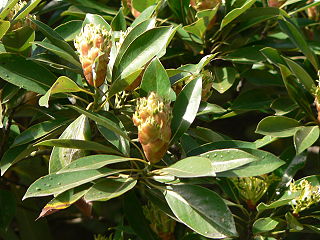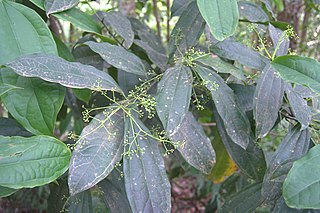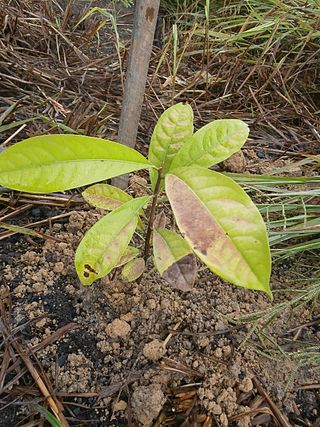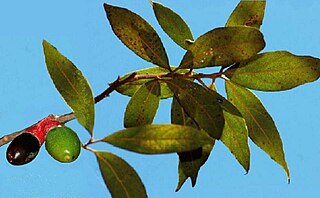
Persea is a genus of about 150 species of evergreen trees belonging to the laurel family, Lauraceae. The best-known member of the genus is the avocado, P. americana, widely cultivated in subtropical regions for its large, edible fruit.

Tiliaceae is a family of flowering plants. It is not a part of the APG, APG II and APG III classifications, being sunk in Malvaceae mostly as the subfamilies Tilioideae, Brownlowioideae and Grewioideae, but has an extensive historical record of use.

Ocotea is a genus of flowering plants belonging to the family Lauraceae. Many are evergreen trees with lauroid leaves.

Cryptocarya is a genus of about 360 species of flowering plants in the laurel family, Lauraceae. Most species are trees, occasionally shrubs, distributed through the Neotropical, Afrotropical, Indomalayan, and Australasian realms. Most plants in the genus Cryptocarya have leaves arranged alternately along the stems, small flowers with 6 tepals, stamens in 2 rows, the inner row alternating with staminodes, and the fruit is a drupe.

Litsea is a genus of evergreen or deciduous trees or shrubs belonging to the laurel family, Lauraceae. The genus includes a large number of accepted species in tropical and subtropical areas of North America and Asia.

Machilus is a genus of flowering plants in the family Lauraceae. It is found in temperate, subtropical, and tropical forest, occurring in China, Korea, Japan, Taiwan, Indochina, the Indian subcontinent, Malaysia, Indonesia, and the Philippines. It is sometimes included in the genus Persea, and currently includes about 100 species.

Phoebe is a genus of evergreen trees and shrubs belonging to the Laurel family, Lauraceae. There are 75 accepted species in the genus, distributed in tropical and subtropical Asia and New Guinea. 35 species occur in China, of which 27 are endemic. The first description of the genus was of the type species P. lanceolata made in 1836 by Christian Gottfried Daniel Nees von Esenbeck in Systema Laurinarum, p. 98.

Actinodaphne is an Asian genus of flowering plants in the laurel family (Lauraceae). It contains approximately 125 species of dioecious evergreen trees and shrubs.

Aiouea is a genus of shrubs and trees in the family Lauraceae. It is native to tropical forests and montane forests of North and South America. The name is a curiosity because it consists entirely of vowels.

Aniba is an American neotropical flowering plant genus in the family Lauraceae. They are present in low and mountain cloud forest in Caribbean islands, Central America, and northern to central South America.

Beilschmiedia is a genus of trees and shrubs in family Lauraceae. Most of its species grow in tropical climates, but a few of them are native to temperate regions, and they are widespread in tropical Asia, Africa, Madagascar, Australia, New Zealand, North America, Central America, the Caribbean, and South America. The best-known species to gardeners in temperate areas are B. berteroana and B. miersii because of their frost tolerance. Seeds of B. bancroftii were used as a source of food by Australian Aborigines. Timbers of some species are very valuable.

Mezilaurus is a genus of plant in the family Lauraceae. It is a neotropical genus consisting of 18-27 species, mostly hardwood evergreen trees, occurring from Costa Rica to the southeast of Brazil. Thirteen species have been identified in Brazil, distributed mostly in the Amazon region. In Rio de Janeiro state only M. navalium (Allemão) Taub. ex Mez has been recorded. Some species have been reported within the Cerrado and in semideciduous forest surrounding the Pantanal Matogrossense. The name Mezilaurus refers to its similar appearance to the genus Laurus.
Pleurothyrium is a genus of flowering plants in the family Lauraceae. It includes 48 species, which are native to Central America and northern South America. Many of the species were first described in a 1993 revision of the genus.

Endlicheria is a neotropical plant genus consisting of approximately 60 species, occurring mostly in northern South America and the Amazon region. Most species are medium-sized trees, sometime up to 40 metres in height, but a few species are shrubs. DNA molecular data shows that it is closely related to Rhodostemonodaphne and Ocotea.
Rhodostemonodaphne is a genus of flowering plants in the family Lauraceae. It is a neotropical genus consisting of approximately 41 species occurring in Central America and northern South America. This genus has many species that are valued for timber. The classification of the genus is unclear since the species in the genus fall into a well-supported but unresolved clade that also includes species with unisexual flowers currently placed in the genera Endlicheria and part of Ocotea.
Aiouea cinnamomoidea is a species of tree in the laurel family (Lauraceae). It is native to the states of Oaxaca and Guerrero in southern Mexico.

Damburneya is a genus of evergreen trees and shrubs in the laurel family (Lauraceae). It is native to tropical regions of North America and South America, with the center of diversity in Central America.
H. Kurz. Fortpflanzungsbiologie einiger Gattungen neotropischer Lauraceen und Revision der Gattung Licaria. Dissertation zur Erlangung der Doktorwürde des Fachbereichs Biologie. Universität Hamburg, Hamburg. 1983.














